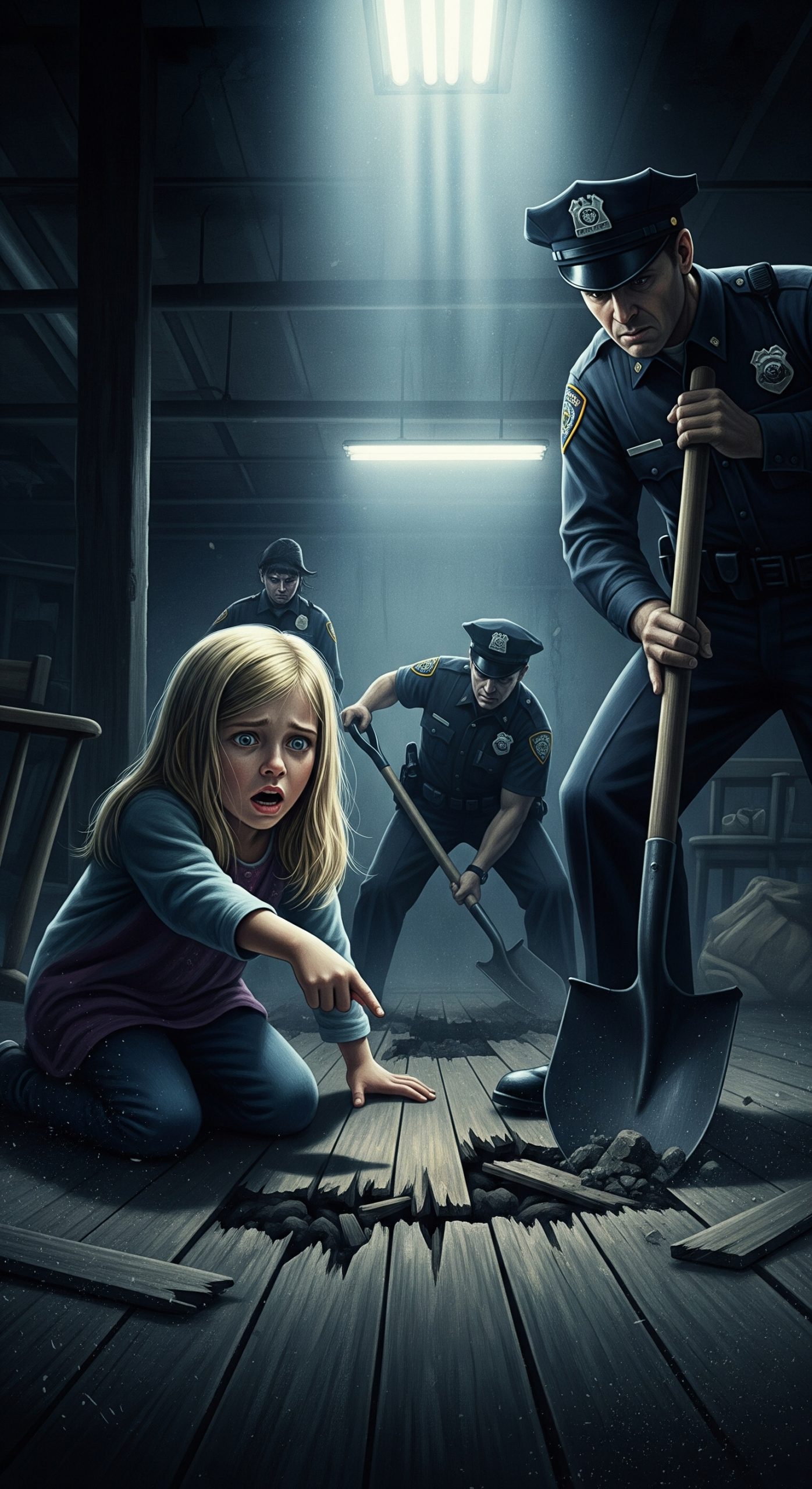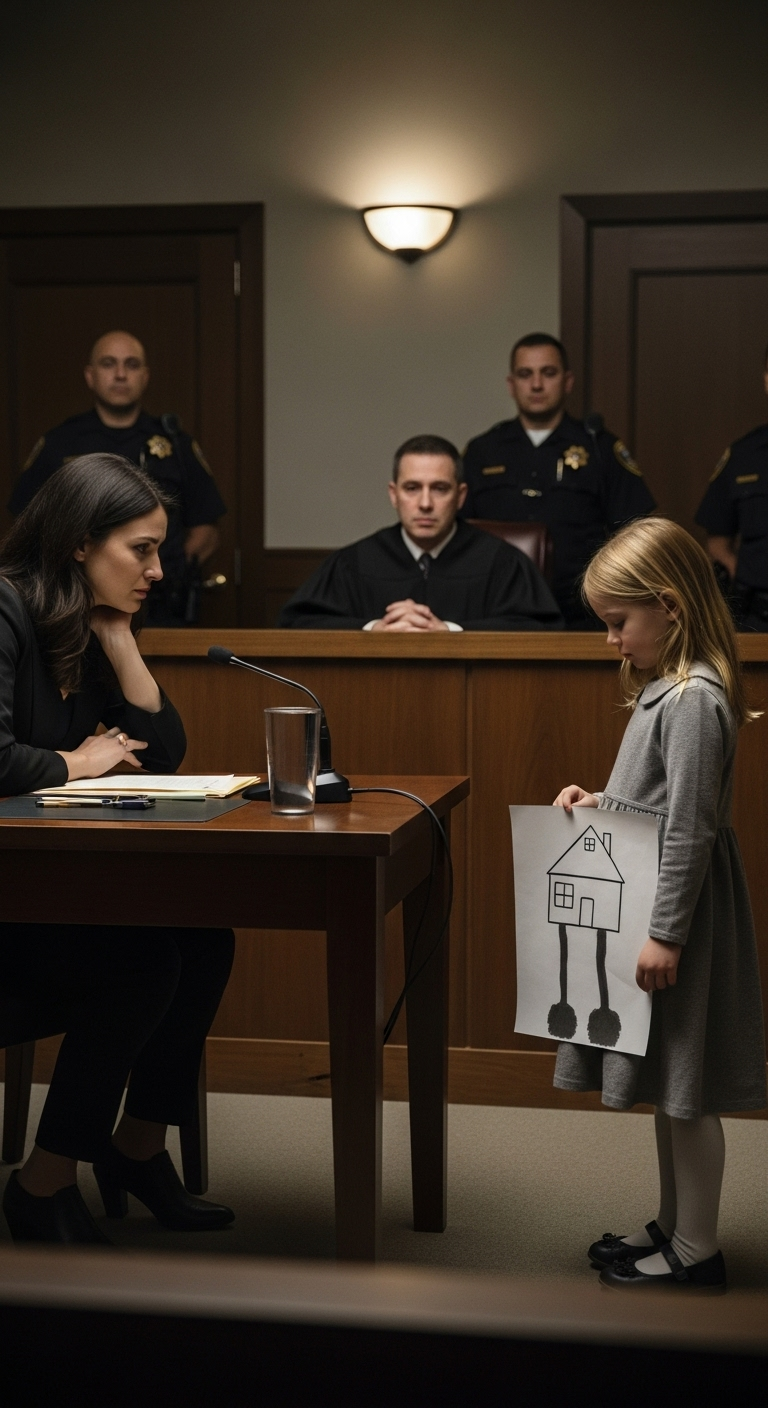It started with a whisper in the middle of a custody hearing. A six-year-old girl tugged on the officer’s sleeve and quietly said, “Daddy isn’t de:ad. He’s under the floor.” Everyone froze.
Her father had been declared missing for nearly a year, presumed dead. But something in her voice—so calm, so sure—chilled the room. The judge paused. The courtroom fell silent. And just hours later, police were tearing up a living room floor, chasing a child’s impossible claim. What they uncovered shocked the nation.
Sometimes, children see the truth that adults won’t believe.

Little Anna hadn’t spoken much since her father disappeared. Her mother told everyone he’d walked out, left them with no explanation. But something always felt off.
Anna would stare at the living room floor when no one was watching. She’d whisper to herself, draw pictures of their home with strange shadows beneath it. Her grandparents had tried asking questions, but Anna always went quiet—until that court day.
Her mother had filed for full custody and was pushing for closure on the missing person case. But as the judge asked if anyone had more to say, Anna did.
“Daddy isn’t gone. He’s here… under the floor, in the dark place where mommy put the boxes.”

At first, no one took it seriously. Trauma, they said. Imagination. But one officer couldn’t shake the unease. The next morning, they requested a welfare check, and with permission, brought in a cadaver dog. That’s when everything changed.
The cadaver dog barked once, then again, circling a specific patch in the living room. The officers looked at each other. The mother insisted it was ridiculous.
“We’ve lived here for years. There’s nothing under there except insulation and dirt,” she snapped.
But when asked to leave the house temporarily for safety, she grew defensive, angry. Then suddenly, nervous.
They brought in ground-penetrating radar. The data returned a large anomaly beneath the foundation, about the size of a person. A warrant was signed by noon. Neighbors gathered behind yellow tape as excavation began.
First came the tiles, then concrete dust, then a plastic tarp. The digging slowed. Cameras rolled. Anna, staying with her grandmother, watched cartoons and ate cereal, unaware of the chaos that was unfolding blocks away.
Then they found it. Human remains. A man still wearing a work badge from the local power company—Anna’s dad.
The autopsy revealed blunt force trauma. Estimated time of death: 11 months earlier. Cause: homicide.
The mother was arrested the same day, trying to board a bus out of state with a fake name. She never admitted guilt, but the evidence was overwhelming: blood traces in the subflooring, a missing hammer, and Anna’s heartbreaking drawings.

She had told the truth in the only way she knew how—and no one had listened until now.
In court, Anna testified through a video statement. Her voice was small, but her words were unforgettable:

“He used to sing to me at night, but then I heard him cry from under the floor.”
The courtroom wept. Her drawings, filled with shadows, hammers, and red marks, were entered as evidence. Prosecutors called it the most chilling child-led discovery in recent history.
The mother was sentenced to life in prison without parole—no appeal, no mercy. The judge cited Anna’s brAnna as the only reason the truth came to light. And as reporters flooded the courthouse, one thing became heartbreakingly clear: Sometimes the smallest voices carry the most profound truths, if only we’re willing to hear them.
Anna now lives with her grandparents in another state—safe and surrounded by love. She’s in therapy, learning to laugh again, healing slowly. Her story made national news, but it also sparked a deeper conversation.
How often do we silence children when their voices don’t fit adult expectations?
Law enforcement agencies across the country began revisiting cold family cases, especially those involving young witnesses. Counselors now use Anna’s story to train adults on listening without judgment.
She was just a little girl, but her courage uncovered a secret buried beneath years of lies. Because truth doesn’t always scream. Sometimes, it whispers from under the floorboards.
